 [This essay came a little late to be included in A Sort of Homecoming: Essays Honoring the Academic and Community Work of Brian Walsh but we wanted to make sure that this contribution from our friends at City Seminary of New York was shared with the Empire Remixed community. Mark R. Gornik (Director) and Sarah Gerth van den Berg (Dean of Curriculum and Pedagogy) reflect on the practice (and metaphor) of walking and its possible resonance with the contribution that Brian has made to theology and urban ministry practice.]
[This essay came a little late to be included in A Sort of Homecoming: Essays Honoring the Academic and Community Work of Brian Walsh but we wanted to make sure that this contribution from our friends at City Seminary of New York was shared with the Empire Remixed community. Mark R. Gornik (Director) and Sarah Gerth van den Berg (Dean of Curriculum and Pedagogy) reflect on the practice (and metaphor) of walking and its possible resonance with the contribution that Brian has made to theology and urban ministry practice.]
One day I walk in flowers
One day I walk on stones
Today I walk in hours
One day I shall be home (Bruce Cockburn)

“One Day I Walk” is from High Winds Bright Sky, the second album of the Canadian musician Bruce Cockburn. A beautiful song, it speaks of human brokenness and possibility, the rural Canadian landscape, and of walking in ways that finds a way home. A pilgrimage. But if songs are also linked to our memories of place and people, “One Day I Walk” reminds me (Mark) of the streets of Toronto and the gift of Brian Walsh.
A few years ago, Brian provided me with an invitation to come to Toronto, to speak in a variety of settings about ministry in the city, theological education, and world Christianity. This was a special grace indeed, but what I remember most was arriving early in a winter morning and Brian saying, “I want to show you Toronto.”
Off we went through the cold and snow, mostly by foot, occasionally by street car. There was breakfast in an old diner in the midst of a changing neighborhood. The University of Toronto and his office larger than many New York apartments. Shops and stores like Jenny’s Convenience.  The St James Cathedral and its welcoming congregation and staff. Apartment buildings that, renovated out of a commitment of faith, continued to serve the poor. A glance down the street where Jane Jacobs had lived. Signs of the First Nations. Conversation around Bruce Cockburn’s music. The Wine Before Breakfast community that meets at 7:22 am for Eucharistic worship. A place called the Yonge Street Mission.
The St James Cathedral and its welcoming congregation and staff. Apartment buildings that, renovated out of a commitment of faith, continued to serve the poor. A glance down the street where Jane Jacobs had lived. Signs of the First Nations. Conversation around Bruce Cockburn’s music. The Wine Before Breakfast community that meets at 7:22 am for Eucharistic worship. A place called the Yonge Street Mission. 
Toronto though Brian’s eyes. Cities and land. Places of faith. Cups of coffee and tea. Music. Pilgrimage. One day I walk…
It is this whole matter of walking in the city that leads us to topic of this essay in Brian’s honor. Walking—being present to the types of roads we travel, attentive to who we meet along the way, finding a way home and home along the way—such themes are at the heart of Brian’s ministry and scholarly labors.
This is all very reflective of Brian’s own story. In his autobiographical essay, “Urban Ministry: Looking for a Place to Call Home,” Brian starts off by describing a visit he made at 16 years of age to the soup kitchen of the Yonge Street Mission in downtown Toronto. The Yonge Street Mission was also reaching out to the youth culture, offering up “coffee, Jesus and folk music.”
It took a “a few months of hanging around” the Yonge Street Mission, but looking back Brian to could see that “I am a follower of Jesus today with a love for good music and a distinct distaste for bad coffee (though I love the good stuff) because of the way in which God worked through that urban ministry in the core of Toronto.”
This unexpected encounter in the city led to new possibilities. No longer “wandering and lost,” Brian expressed a sense of home in God, in the body of Christ, and in the city of Toronto.
Brian’s formative experiences at the Yonge Street Mission suggests that they impact on his pedagogy and theology. Grounded in the context of his urban experiences while also covering the familiar arc of creation, the fall, and redemption in the Reformational tradition, Brian’s community and scholarly work addresses the times though the materials of Scripture, the people he meets, music, and the arts.
As Brian’s experience also shows, a uniquely effective way to learn about a city is not simply through an academic course, but through an embodied way of developing knowledge. Taking risks and recognizing the risks of others can lead to new forms of knowledge and practice, a richer appreciation of Christian belief and experience.
Experience is a notable part the tradition of Ignatian spirituality. It begins with Christ through the eyes of faith, as found in 1 Peter 1:8.
“Although you have not seen him you love him;
and even though you do not see him now,
you believe in him and rejoice
with an indescribable and glorious joy.”
In response to God’s love in Christ, Ignatian spirituality also invites an embrace of the senses of sight, touch, taste, hearing and smell. In this contemplative way of being, we are able to grasp more fully where God is present, in the city and world.
The social sciences can also enrich our increasing awareness of the world we inhabit through multi-sensory practice. In Sarah Pink’s essay “An Urban Tour: The Sensory Sociality of Ethnographic Place-Making,” she not only walks, but also eats as part of her ethnographic practice. Pink’s work emphasizes the social dimension of everyday life, the spaces we enter and help make. Walking and food are part of this.
These perspectives can help lead us from coffee at Yonge Street and breakfast on the Toronto walk, to the streets of New York and the kitchens in the ancient global city of Rome.
At City Seminary of New York, we have embraced walking in the city as a core practice of our pedagogy. One way we do this is through a communal practice called “pray and break bread” or pbb. The core elements of each pbb include meeting in a neighborhood, listening to someone in the community relate their perspective, hearing Scripture together, going out in smaller groups to walk and pray in various ecclesial styles and traditions, then meeting together for a meal and breaking of bread together. We do at least five times as a year at the seminary, in different neighborhoods throughout the city.
For example, the neighborhoods around the Queens 7 train line—dubbed “the international express”—are important places where we walk and pray and learn, attentive to the layers of indigenous, Dutch, British, and more recently, Chinese, Indian, Peruvian, Brazilian, Polish, Vietnamese communities. When our friend Sung Lee met our students and faculty in Queens, he and others shared experiences of growing up in Queens over different generations. We learn to ground-truth our understandings, to listen to those who live in a place about its challenges and promises. Along the way, the smoothie stands, Asian market stalls, evoke a range of memories and spark the sharing of stories about home amongst the walking group.
Having lived, raised his family, and pastored in Jackson Heights and Elmhurst for decades, Sung guides us in linking our observations to challenges in the neighborhood, such as human trafficking, as well as witnessing firsthand the fruits of the city, such as the ways in which the Queens Public Library — bustling with kids, elders, families, students, on a chilly Saturday in November, and titles in Bengali, Mandarin, and Spanish — designs their offerings to meet the interests and needs of a community that speaks dozens of languages.  This not only forms out attention to the city, religiously, politically and ethically, but from the ground up, enables us to see the neighborhood through the eyes of the community and God, just as the walk Brian took Mark on.
This not only forms out attention to the city, religiously, politically and ethically, but from the ground up, enables us to see the neighborhood through the eyes of the community and God, just as the walk Brian took Mark on.
A second way we walk in the city is through “urban pilgrimage.” In our graduate program, a Master of Arts degree in “Ministry in the Global City,” students and faculty travel to cities in Africa, Asia or Latin America. It is not a mission trip or service learning, but a pilgrimage to see what God is doing in the city. While we use every mode of transportation, from public buses in Johannesburg, South Africa to cable cars in Medellín, Colombia, at the heart of an urban pilgrimage is walking and being sensory aware. Taking in the smells, the foods, the streets, the textures and hearing new voices, urban pilgrimage is learning through being present, even as it unsettles, challenges, and opens us to different ways of being in relation to each other and our world. This is a critical and ethical dimension to the practice of walking in the city.
Perhaps this experience of walking and sensing the city, being challenged through new encounters and voices, from his time at the Yonge Street Mission through his work as a chaplain at University of Toronto, has also shaped Brian’s interaction with Scripture, the hermeneutics that inform his biblical scholarship. As Emmanuel Katongole observes, a key element of pilgrimage is “interruption”: gaining knowledge though encounters that were unexpected and can change us.
Brian, with Sylvia Keesmaat, has made important contributions to the study of the Apostle Paul. With N.T. Wright, they emphasize the transformative power of the Gospel as a new story of the world, and the challenge that comes from reading Paul in and for our times.
One of the most unique features of Colossians Remixed and Roman’s Disarmed, co-authored studies with Keesmaat, is the introduction of new characters who are actively hearing and being engaged by the text in the first century. They become our companions in hearing the Gospel, but also voices we may need to hear. This is at once unexpected, but important in hearing the text, then and now. This is also where the writing of targums becomes crucial, connecting the Biblical text with interpretive practice.
 In Colossians Remixed, they introduce Nympha, a business woman in the city of Colossae. A textile manufacturer, Nympha herself lives in Laodecia. It is on a trip to check on her weavers and dyers in Colossae, that she hears from Lydia, who tells her the good news of Jesus and the Gospel. Nympha tries to reconcile how what Lydia is telling her fits with the Roman ideology of her time. As Brian and Sylvia develop her character, we are invited to walk through the city of Colossae as Nympha does:
In Colossians Remixed, they introduce Nympha, a business woman in the city of Colossae. A textile manufacturer, Nympha herself lives in Laodecia. It is on a trip to check on her weavers and dyers in Colossae, that she hears from Lydia, who tells her the good news of Jesus and the Gospel. Nympha tries to reconcile how what Lydia is telling her fits with the Roman ideology of her time. As Brian and Sylvia develop her character, we are invited to walk through the city of Colossae as Nympha does:
Throughout the next few weeks I gazed around as I went about my business. Everywhere I turned there were images of Caesar … I began to notice other things that Lydia had mentioned. I visited my farms near Laodicea and for the first time I saw the despair in the eyes of those who were now slaves on the land they once owned. I saw that while peace had brought prosperity for me, it had also brought greater poverty to these proud farmers…I was disturbed. Lydia had offered a challenge to my faith in the empire.
The character herself is engaged in this contextual critical walking, hearing, seeing and having her world view changed. Nympha has her own moment of “ground-truthing,”: of testing what you are told against the reality experienced through the body’s experience of the city’s material conditions.
 In Romans Disarmed, Brian and Sylvia introduce the character Nereus, a Judean craftsman who is making a dangerous journey by night to hear Paul’s letter read in the workshop of Prisca and Aquila. Brian and Sylvia’s attention to the material conditions of the world is evident in the perspective of Nereus’ character they develop, as he walks:
In Romans Disarmed, Brian and Sylvia introduce the character Nereus, a Judean craftsman who is making a dangerous journey by night to hear Paul’s letter read in the workshop of Prisca and Aquila. Brian and Sylvia’s attention to the material conditions of the world is evident in the perspective of Nereus’ character they develop, as he walks:
It was a slow walk through the crowded streets, over the river to the foot of the Aventine Hill. After awhile I noticed that the air had changed. It still smelled link donkeys and rotting food; that was normal, and dust and smoke were everywhere, but the pungent stink of the tanners was gone. The shopfronts also had more carvings and bigger figures of the gods with more colorful murals. And although apartments still rose on the third and fourth stories, they looked more solid, slightly better built. It wasn’t a long journey, but I felt as though I had entered a different city.
In this creative practice of entering into Scripture through the smelly materiality of ancient Rome, Brian and Sylvia model a hermeneutic of interpreting Scripture in light of what one observes on the ground as one walks: the kinds of images one passes by, the smells that signal different kinds of work and degrees of status, the sorts of precarity or relative comfort one might live in.
In some ways, the workshop of Prisca and Aquila is to Nereus’ character, who we meet in the crowded tent makers studio, what Yonge Street Mission, a dingy basement in 1960’s Toronto, was to Brian. He never really left Yonge Mission, finding home in the Word and in the crowded kitchen halls of Rome.
Home and homecoming are major themes in Brian’s work, beginning with the Yonge Street Mission. If we are on pilgrimage, we are on our way home. Home is belonging, arriving at a place where “peace and balance are the rule.” Home is an answer to our laments, to our brokenness, to the groaning of creation. Home is, following Biblical writers and Saint Augustine, the city as cosmos renewed, where all is shalom (Isa. 65, Rev. 21).
The theme of home is not only prominent in the musical canon of Bruce Cockburn, but also the music of U2. Indeed, the title of this volume honoring Brian appears to be a reference to the U2 song “A Sort of Homecoming” from The Unforgettable Fire. A profoundly spiritual song, it carries us along on a journey.
And you know it’s time to go
Through the sleet and driving snow
Across the fields of mourning
Light in the distance
This is a journey Brian has helped us to find, and with it, a recognition that “The Word took on flesh and moved into the neighborhood. And when Jesus is in the neighborhood, people get to come home.”
A pilgrimage, a journey toward the home of God. A city, “God knows, what a beautiful city.” With music, friends, and good coffee (and tea) along the way. Home as new creation.
Bibliography
Bruce Cockburn, “One Day I Walk,” on High Winds Bright Sky, True North, 1971
____________. “Twelve Gates to the City,” on “Bone on Bone,” 2017.
____________. “Waiting for a Miracle,” on Waiting for a Miracle, 1987.
Philip Endean, S.J. “Contemplation,” in The Cambridge Encyclopedia of the Jesuits, Thomas Worcester SJ ed, Cambridge: Cambridge University Press, 2017, pp 200-201
Mark R. Gornik and Maria Liu Wong, Stay in the City: How Christian Faith is Flourishing in an Urban World. Grand Rapids: Eerdmans, 2017.
Emmanuel Katongole, “A Tale of Many Stories,” in Shaping a Global Theological Mind, ed Darren C. Marks, Burlington: Ashgate, 2008, pp. 89-93.
Sylvia C. Keesmaat and Brian Walsh, Colossians Remixed: Subverting the Empire, Downers Grove: InterVarsity Press, 2004.
____________. Romans Disarmed: Resisting Empire, Demanding Justice. Grand Rapids: Baker 2019.
Sarah Pink, “An urban tour: The sensory sociality of ethnographic place-making.” Ethnography 9.2 (2008): 175-196.
Stephanie Springgay and Sarah E. Truman, Walking Methodologies in a More-than-Human-World: WalkingLab, London: Routledge, 2018.
Gordon J. Spykman, Reformational Theology: A New Paradigm for Doing Dogmatics, Grand Rapids: Eerdmans, 1992.
U2, “A Sort of Homecoming,” The Unforgettable Fire, Island Records, 1985.
Brian Walsh, Kicking at the Darkness: Bruce Cockburn and the Christian Imagination. Grand Rapids: Brazos Press, 2001.
___________. “One Day I Shall Be Home.” Christianity and the Arts, Winter 2000, 7:1, 28-32.
___________. “Urban Ministry: Looking for a Place to Call Home,” The Banner, April 20, 2012.
N.T. Wright, Paul: A Biography, New York: HarperOne, 2018.

